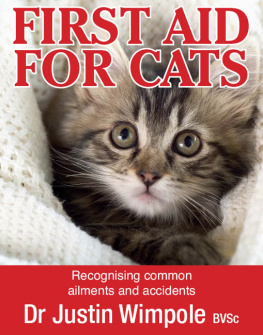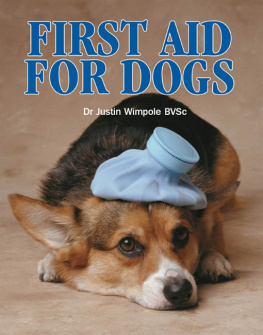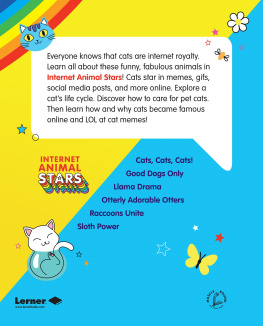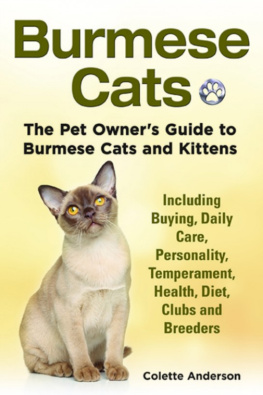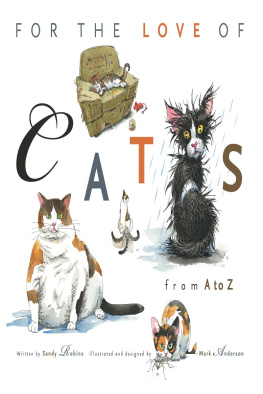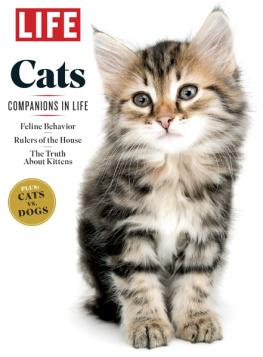First Aid for Cats
First published in Australia in 2007 by
New Holland Publishers (Australia) Pty Ltd
Sydney Auckland London Cape Town
www.newholland.com.au
14 Aquatic Drive Frenchs Forest NSW 2086 Australia
218 Lake Road Northcote Auckland New Zealand
86 Edgware Road London W2 2EA United Kingdom
80 McKenzie Street Cape Town 8001 South Africa
Copyright 2007 in text: Justin Wimpole
Copyright 2007 in images: Kate Patterson
Copyright 2007 New Holland Publishers (Australia) Pty Ltd
All rights reserved. No part of this publication may be reproduced, stored in a retrieval system or transmitted, in any form or by any means, electronic, mechanical, photocopying, recording or otherwise, without the prior written permission of the publishers and copyright holders.
National Library of Australia Cataloguing-in-Publication Data:
ISBN: 978-1-74110-475-2
eISBN 9781921655241
First Aid for Cats
By Dr Justin Wimpole BVSc (hons)
Acknowledgments
I am fortunate to have had a lot of people encourage me to write this book and they all deserve my gratitude.
Firstly, I am most appreciative of the support provided by my partner, Kate, who is also a veterinarian and provided the illustrations. My parents, Helena and Denis, and my brother Martin have also always been full of praise and encouragement. Kates family, especially Roger, has also been very supportive.
It would be remiss of me not to express my gratitude and admiration for my feline friend Beetle and canine companion Milo, who were present for almost every word I wrote and provided unconditional affection.
My friends are also an endless source of motivation. My colleagues at the Veterinary Specialist Centre continue to provide me with inspiration.
I thank Fiona Schultz and the staff at New Holland and my agents Xavier Waterkeyn and Clare Calvert at Flying Pigs for their support. Finally and most importantly, I would like to thank all of my patients who continue to stimulate me and teach me new things every day.
Contents
Introduction
Cats are very special creatures that play a unique role in our lives. Human populations tend to attract rodentsand hence catsso cats have been drawn to us to form a mutually beneficial relationship that remains to this day. There is evidence of the domestic cat living with humans in ancient Egyptian times and possibly even earlier. The importance of the cats role as a rodent hunter is accentuated by the bubonic plague, which was spread by fleas on rats and resulted in the death of one quarter of Europes human population. Domestic cats played a role in bringing the rodent population under control, stemming the spread of disease.
The way that cats relate to humans has essentially not changed throughout history. Evidence to support this is the fact that although there are many different breeds of domestic cat, they are very similar in size; the well-defined role that cats play means that humans have not had to select heavily for specific characteristics. This is very different when it comes to dogs, where people have created various breeds of dog that vary vastly in size and shape for more specific roles.
Contrary to popular opinion, cats can be very social animals. Some wild cats including lions and cheetahs do live socially. Similarly, the domestic cat can live with other cats, people and dogs. Cats are often seen as animals that tolerate people because of the benefits we provide them rather than actually living with us for our companionship; this is why people often say that dogs have owners, cats have staff. However, domestic cats are not simply living with humans because of the nutritional benefits they provide, loving relationships exist between cats and people and these bonds can be extremely strong. Domesticated cats are able to become feral and live independently of people but so often choose not to and are often bonded to specific individualsother cats, dogs or peopleand can be very loyal.
Although cats are are normally perfectly able to look after themselves and give back to us at least as much as we give them, when they are sick or injured they are completely dependent on us. When this is the case we want to do whatever we can to help them. There are many hazards for our feline friends, but we may feel helpless or ill prepared to be of any assistance. Adding to the challenge, cats are especially good at hiding their illnesses and often by the time they are showing signs of severe illness their condition is quite advanced. Also cats do not always like being examined and treated, even when they are well. These issues can make administering first aid and veterinary care to cats difficult. Fortunately there are 24-hour emergency animal health centres in most capital cities and regional centres. Most areas have veterinarians who provide after-hours service on a call-out basis. In most cases the best thing that you can do for a sick or injured cat is to seek prompt veterinary attention for professional assessment and access to diagnostic testing and timely treatment.
Unfortunately not all cat owners have access to veterinary attention at all times. This book provides some basic information to cat owners and carers to help them avoid an emergency, recognise an emergency and better equip them to act appropriately. It by no means aims to replace or delay veterinary assistance. Treating it as such is dangerous and could put your cats life at risk. You should only intervene when it is imperative that something is done immediately, when you have no access to veterinary attention or when veterinary attention is far away. Sometimes an owner can save their cats life by giving appropriate first aid.
When I provide veterinary attention to animals, I always attempt to apply the philosophy of do no harm. The information in this book is presented with this principle in mind. Unfortunately when owners or even veterinarians try to help a sick or injured cat, there is the potential to do more harm. This is obviously not intentional. It is imperative that first aid given to a sick or injured cat helps the cats situation rather than making it worse.
By reading this book to better equip yourself for emergencies involving your cat, you are showing a real commitment to your companion. Hopefully you will never need to use the information presented in this book, but should the need arise you will be better equipped to deal with the situation.
Disclaimer
This book was written to offer cat owners and lovers first aid advice on dealing with emergencies involving cats. The advice is general in nature.
It was written using veterinary knowledge and experience, but should never be used as a substitute for professional assessment, advice or care. In some instances providing first aid has the potential to cause harm to the patient and the person providing it. It is the responsibility of the reader to consider these risks when deciding on a course of action in any particular situation. Readers should be aware that, even with the benefit of a veterinary hospital setting, the outcome of emergency situations can be undesirable including permanent injury or loss of life. Results can be expected to be even less successful in the field situation.
The author and publisher cannot be held responsible for any loss or personal injury caused by the application of any advice provided in this book.
If in doubt, please contact your nearest veterinary hospital immediately.
Being Prepared
The most important aspect of being prepared for an animal emergency is to have a good relationship with your veterinarian. You can easily achieve this simply by attending to your cats routine preventative medical requirements, such as having your cat vaccinated and examined regularly. With regular consultations you will learn about flea control, intestinal worm and heartworm prevention, diet and other aspects of caring for your cat. Seeing your veterinarian regularly will also allow them to identify and manage your cats individual issues and be aware of them in case of an emergency.


